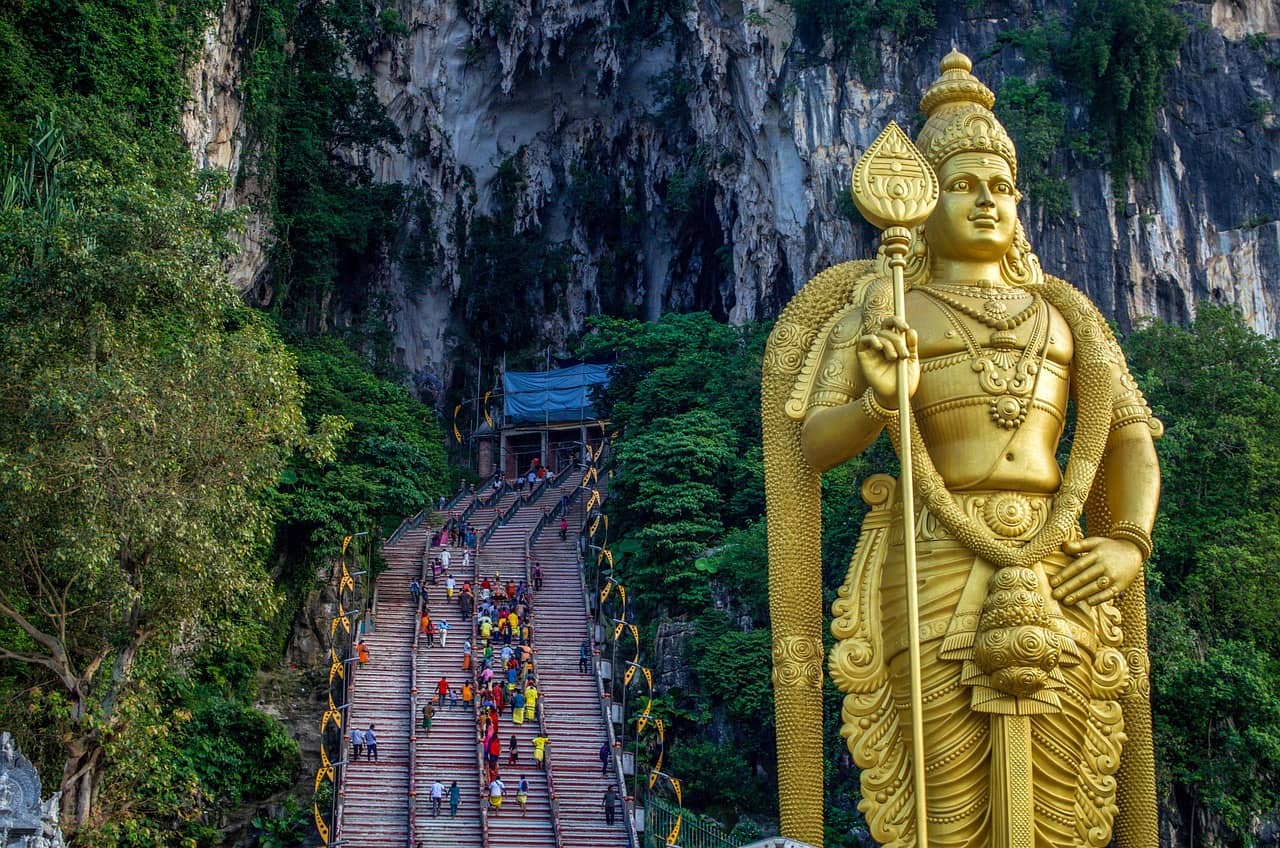Nestled on the outskirts of Kuala Lumpur, Malaysia, the Batu Caves is a captivating destination that combines natural beauty, spiritual significance, and cultural diversity. This remarkable complex of limestone caves and cave temples is a testament to the rich tapestry of history and traditions that make Malaysia a unique and fascinating country. In this comprehensive article, we will delve into the world of Batu Caves, unveiling their geological formation, historical significance, cultural importance, contemporary relevance, and the fascinating cave exploration experience they offer.
Geological Formation
The Batu Caves owe their existence to approximately 400 million years of geological processes. These caves are part of a vast limestone hill range, formed primarily from limestone deposits that date back to the Middle Paleozoic era. Over millions of years, the caves have been eroded and shaped by water, giving them their unique and stunning appearance. The most prominent feature of the Batu Caves is the colossal golden statue of Lord Murugan, which stands proudly at the entrance, guarding the sacred interior.
Historical Significance
Batu Caves are deeply rooted in history and have been used by various cultures for centuries. The word “Batu” means rock in the Malay language, and these caves are believed to have been named after the Sungai Batu, a nearby river. The caves have a long history of human habitation, dating back to the indigenous Temuan people.
The spiritual importance of Batu Caves became more pronounced during the 19th century when Chinese settlers established a temple within one of the caves. In the late 1800s, Indian laborers brought in by the British colonial authorities began to settle around the caves, and their influence is evident in the numerous Hindu shrines and temples that can be found inside today.
Cultural Importance
Batu Caves serve as a microcosm of Malaysia’s diverse cultural heritage. The caves are home to a multitude of Hindu shrines and temples, which are visited by both local devotees and tourists. The most prominent of these is the Sri Subramaniar Swamy Temple, dedicated to Lord Murugan, the Hindu god of war and victory. The statue of Lord Murugan, standing at a towering 42.7 meters, is a stunning sight and the tallest statue of a Hindu deity in Malaysia. Devotees and tourists alike climb a steep flight of 272 steps to reach the main cave and pay their respects.
The annual Thaipusam festival is the most significant event at Batu Caves. This Hindu festival, celebrated in January or February, draws thousands of devotees who carry ornate kavadis (burdens) and pierce their bodies with various objects in a demonstration of devotion and penance. The vibrant and colorful processions and rituals during Thaipusam are a sight to behold, attracting people from all walks of life.
Cave Exploration at Batu Caves
While Batu Caves are renowned for their historical and cultural significance, the site also offers an extraordinary exploration of four distinct caves, each with its unique charm and character.
- Cathedral Cave (Temple Cave): The towering and majestic Cathedral Cave, also known as the Temple Cave, is the primary attraction at Batu Caves. Accessible via a steep flight of 272 steps, this high-ceilinged cave is a marvel of natural limestone formations and religious sanctity. Inside, visitors are greeted with numerous Hindu shrines and idols, and the focal point is the grand golden statue of Lord Murugan at the entrance. The cavernous interior exudes an aura of spirituality and awe-inspiring beauty, making it a must-visit for anyone exploring Batu Caves.
- Art Gallery Cave: For those interested in delving deeper into Hindu mythology and art, the Art Gallery Cave is a treasure trove of intricate paintings and statues. The cave’s walls are adorned with colorful depictions of Hindu deities, mythological scenes, and cultural motifs. Visitors can take their time to admire the craftsmanship and gain a deeper understanding of the rich symbolism inherent in Hindu culture.
- Museum Cave: Adjacent to the Art Gallery Cave, the Museum Cave offers an educational experience, providing insights into the history and cultural significance of Batu Caves. Here, visitors can explore a collection of artifacts, historical items, and displays that narrate the evolution of this extraordinary site. It’s a place where the past and present converge, allowing visitors to appreciate the enduring legacy of Batu Caves.
- Dark Cave: Beyond the spiritual and cultural aspects, Batu Caves harbor a different world in the form of the Dark Cave. This ecologically focused cave is a sanctuary for a unique and diverse ecosystem of rare species. Guided tours into the Dark Cave offer visitors the opportunity to learn about its biodiversity and the ongoing conservation efforts. Inside, you’ll encounter fascinating creatures such as insects, bats, and other cave-dwelling animals. Exploring the Dark Cave not only sheds light on the natural wonders within Batu Caves but also raises awareness about the importance of preserving these delicate ecosystems.
These four caves collectively make up the Batu Caves complex, and each offers a distinct experience for visitors. Whether you seek spiritual enlightenment, artistic inspiration, historical insight, or an encounter with the natural world, Batu Caves provides a multifaceted journey that appeals to a wide range of interests. It’s a place where history, spirituality, culture, and conservation converge, making it a truly extraordinary destination in Malaysia.
Visiting Batu Caves
Batu Caves are conveniently located about 13 kilometers north of Kuala Lumpur, making them easily accessible. To visit the caves, you can take a taxi, use a ride-sharing service, or hop on the KTM Komuter train from KL Sentral station, which stops at Batu Caves. The train station is situated just a short walk away from the entrance to the caves.
When visiting Batu Caves, it is essential to dress modestly, covering your shoulders and knees as a sign of respect for the religious significance of the site. Additionally, be mindful of the monkeys that inhabit the area; while they can be entertaining, they are known to be mischievous and may snatch food or belongings.
Frequently Asked Questions (FAQs)
Q1: What are Batu Caves?
A: Batu Caves are a series of limestone caves and cave temples situated just north of Kuala Lumpur, Malaysia. The caves are one of the most popular Hindu shrines outside of India and attract visitors from around the world.
Q2: How do I get to Batu Caves from Kuala Lumpur?
A: Batu Caves are easily accessible from Kuala Lumpur. You can take a short train ride on the KTM Komuter train from Kuala Lumpur Sentral to Batu Caves station. Alternatively, you can hire a taxi or use ride-sharing services.
Q3: Is there an entrance fee to Batu Caves?
A: Access to Batu Caves is free, but there may be a small fee for certain attractions within the complex, such as the Dark Cave and the Ramayana Cave.
Q4: What should I wear when visiting Batu Caves?
A: Since Batu Caves is a religious site, it’s advisable to dress modestly out of respect. Avoid wearing revealing clothing, and it’s recommended to cover your shoulders and knees. Comfortable footwear is also recommended as there are steep steps to climb.
Q5: Are there any specific rules for visitors at Batu Caves?
A: Yes, visitors are expected to adhere to certain rules. It’s customary to remove your shoes before entering the temples, and be mindful of the local customs and religious practices. Photography is generally allowed, but it’s important to be respectful and not disturb worshipers.
Q6: What is the best time to visit Batu Caves?
A: The best time to visit Batu Caves is during the early morning or late afternoon to avoid the heat. Additionally, if you plan your visit during the Thaipusam festival (usually in January or February), you can witness the spectacular celebrations.
Q7: Are there facilities available at Batu Caves?
A: Yes, there are facilities such as restrooms, souvenir shops, and eateries available at Batu Caves. It’s advisable to carry some water and snacks, especially if you plan to explore the caves and surrounding areas.
Q8: Can I explore the caves on my own?
A: Yes, you can explore the main cave on your own. However, if you’re interested in a more in-depth experience, guided tours, especially to the Dark Cave, are available for a more informative and educational visit.
Q9: How long does it take to explore Batu Caves?
A: The time needed to explore Batu Caves can vary. A visit to the main cave usually takes around 1-2 hours, but if you plan to explore the surrounding areas, visit the museums, or take guided tours, it’s recommended to allocate half a day for your visit.
Q10: Are there any nearby attractions to visit?
A: Yes, the Batu Caves area has other attractions, including the Ramayana Cave, the Art Gallery, and the Dark Cave. Additionally, the Royal Selangor Pewter Factory and the Kanching Rainforest Waterfall are within a short driving distance.
Batu Caves is a true Malaysian gem that seamlessly blends natural beauty, history, spirituality, culture, and conservation. It stands as a testament to Malaysia’s remarkable diversity and offers a captivating experience for both tourists and locals. The awe-inspiring limestone formations, intricate temples, and cultural celebrations make Batu Caves an essential destination for anyone seeking to explore the heart and soul of this beautiful Southeast Asian nation. It is a place where history, spirituality, culture, and nature converge, providing a profound and enriching experience that will linger in the memories of visitors for years to come.
Explore our 5 Days Travel Guide To Malaysia





